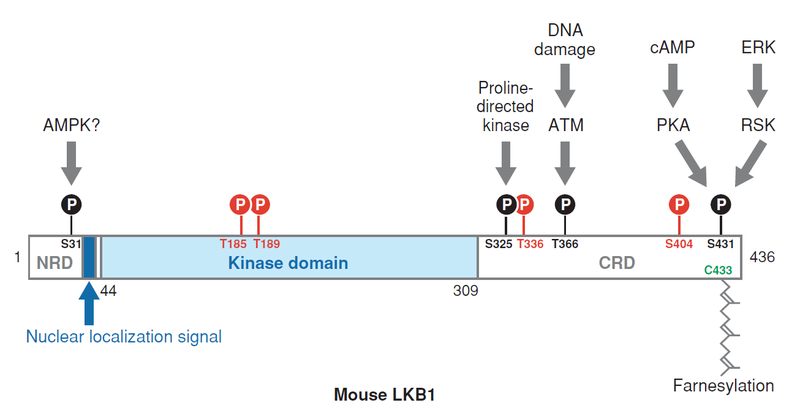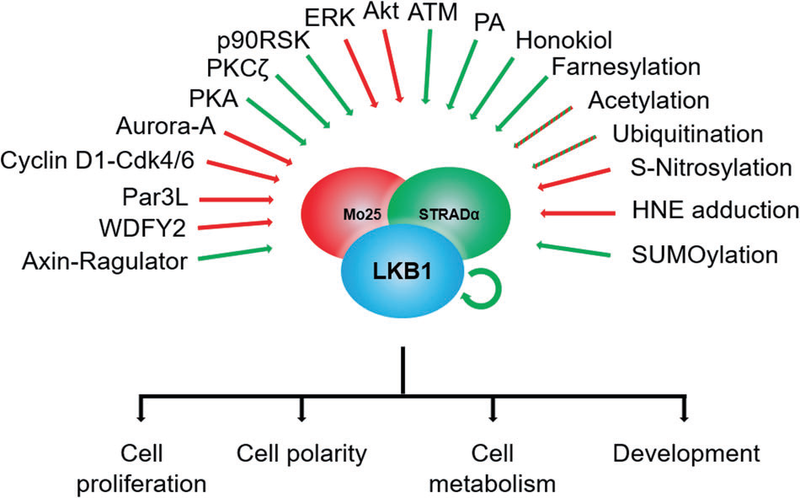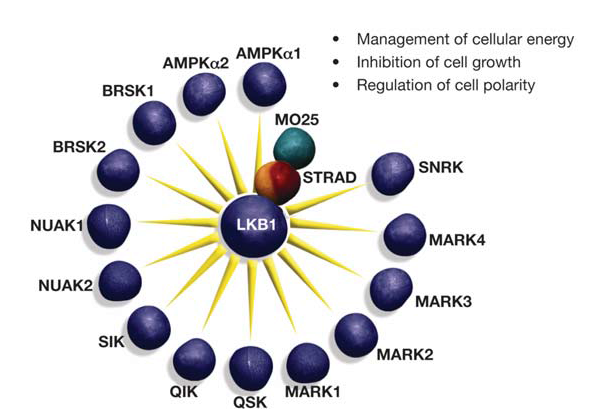LKB1
LKB1, Liver Kinase B1, STK11 (Serine/Threonine Kinase 11) Ver. 0.1.
Contents
Summary remarks
Tumor suppressor serine/threonine-protein kinase that controls the activity of AMP-activated protein kinase (AMPK) family members, thereby playing a role in various processes such as cell metabolism, cell polarity, apoptosis and DNA damage response. Acts by phosphorylating the T-loop of AMPK family proteins, thus promoting their activity: phosphorylates PRKAA1, PRKAA2, BRSK1, BRSK2, MARK1, MARK2, MARK3, MARK4, NUAK1, NUAK2, SIK1, SIK2, SIK3 and SNRK but not MELK. Also phosphorylates non-AMPK family proteins such as STRADA, PTEN and possibly p53/TP53. Acts as a key upstream regulator of AMPK by mediating phosphorylation and activation of AMPK catalytic subunits PRKAA1 and PRKAA2 and thereby regulates processes including: inhibition of signaling pathways that promote cell growth and proliferation when energy levels are low, glucose homeostasis in liver, activation of autophagy when cells undergo nutrient deprivation, and B-cell differentiation in the germinal center in response to DNA damage. Also acts as a regulator of cellular polarity by remodeling the actin cytoskeleton. Required for cortical neuron polarization by mediating phosphorylation and activation of BRSK1 and BRSK2, leading to axon initiation and specification. Involved in DNA damage response: interacts with p53/TP53 and recruited to the CDKN1A/WAF1 promoter to participate in transcription activation. Able to phosphorylate p53/TP53; the relevance of such result in vivo is however unclear and phosphorylation may be indirect and mediated by downstream STK11/LKB1 kinase NUAK1. Also acts as a mediator of p53/TP53-dependent apoptosis via interaction with p53/TP53: translocates to the mitochondrion during apoptosis and regulates p53/TP53-dependent apoptosis pathways. In vein endothelial cells, inhibits PI3K/Akt signaling activity and thus induces apoptosis in response to the oxidant peroxynitrite (in vitro). Regulates UV radiation-induced DNA damage response mediated by CDKN1A. In association with NUAK1, phosphorylates CDKN1A in response to UV radiation and contributes to its degradation which is necessary for optimal DNA repair. (https://www.uniprot.org/uniprot/Q15831)
Structure
The structure of the mouse LKB1 protein with regulation sites is presented on Figure 2 from (Alessi 2006) [1].
Figure 2. Posttranslational modification sites of the mouse LKB1 protein. Autophosphorylation sites are depicted in red, and the sites phosphorylated by other kinases are in black. The Cys433 farnesylation site is depicted in green. The agonists and upstream protein kinases postulated to phosphorylate each site are indicated. Residues Thr366, Ser404, Ser431, and Cys433 in the mouse sequence correspond to human LKB1 residues Thr363, Thr402, Ser428, and Cys430, respectively. The noncatalytic domains are in white, and the kinase domain is light blue.
Action
Acts as a key upstream regulator of AMPK by mediating phosphorylation and activation of AMPK catalytic subunits PRKAA1 and PRKAA2 and thereby regulates processes including: inhibition of signaling pathways that promote cell growth and proliferation when energy levels are low, glucose homeostasis in liver, activation of autophagy when cells undergo nutrient deprivation, and B-cell differentiation in the germinal center in response to DNA damage.
Kinetics
Pathways
Upstream
In general, upstream pathways presented at figure from (Kullmann 2018) [2].
Figure 1. (Kullmann_2018). Schematic summary of upstream regulatory factors affecting LKB1 function in its four core functions. Red arrows represent inhibitory functions whereas green arrows indicate an activation of LKB1.
(Woods 2003) [3]. LKB1 is phosphorylated by a number of protein kinases at distinct sites, although the role of phosphorylation on LKB1 activity is unclear. AMPKK activity is known to be unaffected by incubation with protein phosphatases [10]. Consistent with this result, incubation of LKB1 with a mixture of protein phosphatases 1, 2A, and 2C had no effect on its ability to activate AMPK.
(Sapkota 2002) [4]. PKA, S6K1, p90RSK and mitogen- and stress-stimulated protein kinase 1 (`MSK1'), phosphorylated LKB1 only at Ser431 and not at Thr336. Following incubation of LKB1 with manganese-ATP in vitro, it becomes phosphorylated at Thr336 as well as Thr366. Phosphorylation of LKB1 does not affect its activity in vitro. Phosphorylation of LKB1 does not alter its nuclear localization.
(Zeqiraj 2009) [5]. In humans, there are two closely related isoforms of STRAD (STRADa and STRADb) and MO25 (MO25a and MO25b) that similarly interact with and activate LKB1. MO25a enhances the ability of STRADa to bind ATP and APD. ATP enhances the ability of STRADa to bind MO25a. Interaction of ATP and MO25a with STRADa controls LKB1 activity, ‘‘active-like’’ conformation of STRADa is maintained through binding to ATP and/or MO25a, and is required for activation of LKB1.
Downstream
LKB1 phosphorylates PRKAA1, PRKAA2, BRSK1, BRSK2, MARK1, MARK2, MARK3, MARK4, NUAK1, NUAK2, SIK1, SIK2, SIK3 and SNRK. Also phosphorylates non-AMPK family proteins such as STRADA, PTEN and possibly p53/TP53. (https://www.genecards.org/cgi-bin/carddisp.pl?gene=STK11)
Figure 4 from (Alessi 2006) [1]. Activation of the AMPK-related kinases by LKB1.
Isoforms
Location
(Alessi 2006) [1]. LKB1, when overexpressed on its own in mammalian cells, is localized mainly in the nucleus, although a small fraction was reproducibly found in the cytoplasm (40–42). LKB1 possesses a nuclear localization signal at its N-terminal noncatalytic region (residues 38–43). When LKB1 is expressed with STRAD and MO25, it becomes strikingly relocalized in the cytoplasm (29, 35, 43). Additional mechanisms may also exist to maintain LKB1 in the cell cytoplasm. The interaction of LKB1 with a protein called LKB1 interacting protein-1 (LIP1) was reported to induce LKB1 cytoplasmic localization in 30% of the cells (44). Whether LIP1 can interact with the heterotrimeric LKB1:STRAD:MO25 complex has not been tested. In addition to interacting with STRAD and MO25 isoforms, a significant pool of cellular LKB1 is associated with a chaperone complex consisting of heat shock protein 90 (Hsp90) and the Cdc37 kinase-specific targeting subunit for Hsp90 (48, 49).
Activity
(Alessi 2006) [1]. LKB1 efficiently phosphorylated AMPK in vitro specifically at Thr172, the residue that becomes phosphorylated when cellular ATP levels fall (65–67). The ability of LKB1 to activate AMPK was enhanced over 100-fold if it was present with isoforms of STRAD and MO25 in a complex (in vitro), demonstrating that these subunits are indeed required for the activation of LKB1 (Hawley 2003) [6] . (Jansen 2009) [7]. LKB1 play its role in metabolic regulation, predominantly through the AMPKα2 isoform.
Activity regulation
(Sebbagh 2011) [8] Functionally, the LKB1 complex presence at the basolateral domain is correlated to its ability to activate one of its substrate, AMPK [53], suggesting that LKB1 complex regulation could be governed through its intracellular localization allowing proximity with its substrates. This eventuality is strengthened by sparse observations in which LKB1 Ser431 phosphorylation reduces its affinity for the membrane [4] as well as its ability to properly activates AMPK [50]. Altogether, this gives rise to the idea that the LKB1 complex is constitutively active and regulation of cellular processes in which it is involved appears dependent of its subcellular localizations.
Outstanding Questions
(Sebbagh 2011) [8] Two human STRAD and MO25 paralogues, defined for both as α and β, have been characterised and appear ubiquitously expressed [43]. Furthermore, at least 4 STRADα [45] and 2 STRADβ isoforms [46] all derived by alternative splicing have been defined. Therefore, cells may express more than one kind of LKB1 complex and in theory could reach up to 16 different ones. Interestingly, some C-terminus STRADα splice variants, missing their MO25 binding motif, keep their ability to induce LKB1 kinase activity in vitro [45]. Nevertheless, this aspect remains unexplored, as LKB1 studies focus almost exclusively on the LKB1-STRADα-MO25α complex, but should be kept in mind since all these potential complexes could have specific functions or regulation modes.
Expression
Serine/Threonine Kinase 11 (https://www.genecards.org/cgi-bin/carddisp.pl?gene=STK11)
Diseases
References
- Alessi DR, Sakamoto K, and Bayascas JR. LKB1-dependent signaling pathways. Annu Rev Biochem. 2006;75:137-63. DOI:10.1146/annurev.biochem.75.103004.142702 |
- Kullmann L and Krahn MP. Controlling the master-upstream regulation of the tumor suppressor LKB1. Oncogene. 2018 Jun;37(23):3045-3057. DOI:10.1038/s41388-018-0145-z |
- Woods A, Johnstone SR, Dickerson K, Leiper FC, Fryer LG, Neumann D, Schlattner U, Wallimann T, Carlson M, and Carling D. LKB1 is the upstream kinase in the AMP-activated protein kinase cascade. Curr Biol. 2003 Nov 11;13(22):2004-8. DOI:10.1016/j.cub.2003.10.031 |
- Sapkota GP, Boudeau J, Deak M, Kieloch A, Morrice N, and Alessi DR. Identification and characterization of four novel phosphorylation sites (Ser31, Ser325, Thr336 and Thr366) on LKB1/STK11, the protein kinase mutated in Peutz-Jeghers cancer syndrome. Biochem J. 2002 Mar 1;362(Pt 2):481-90. DOI:10.1042/0264-6021:3620481 |
- Zeqiraj E, Filippi BM, Goldie S, Navratilova I, Boudeau J, Deak M, Alessi DR, and van Aalten DM. ATP and MO25alpha regulate the conformational state of the STRADalpha pseudokinase and activation of the LKB1 tumour suppressor. PLoS Biol. 2009 Jun 9;7(6):e1000126. DOI:10.1371/journal.pbio.1000126 |
- Hawley SA, Boudeau J, Reid JL, Mustard KJ, Udd L, Mäkelä TP, Alessi DR, and Hardie DG. Complexes between the LKB1 tumor suppressor, STRAD alpha/beta and MO25 alpha/beta are upstream kinases in the AMP-activated protein kinase cascade. J Biol. 2003;2(4):28. DOI:10.1186/1475-4924-2-28 |
- Jansen M, Ten Klooster JP, Offerhaus GJ, and Clevers H. LKB1 and AMPK family signaling: the intimate link between cell polarity and energy metabolism. Physiol Rev. 2009 Jul;89(3):777-98. DOI:10.1152/physrev.00026.2008 |
- Sebbagh M, Olschwang S, Santoni MJ, and Borg JP. The LKB1 complex-AMPK pathway: the tree that hides the forest. Fam Cancer. 2011 Sep;10(3):415-24. DOI:10.1007/s10689-011-9457-7 |


